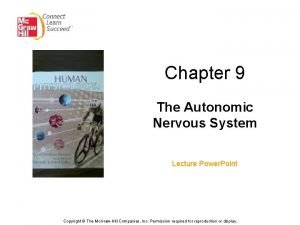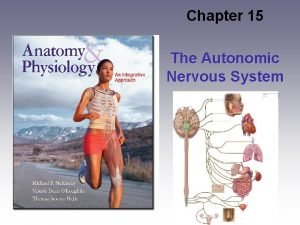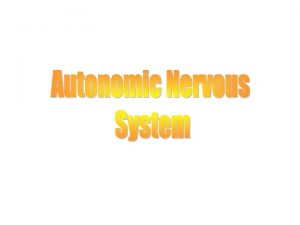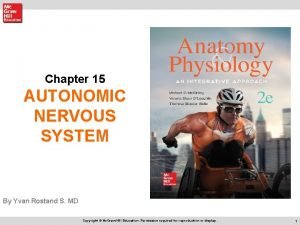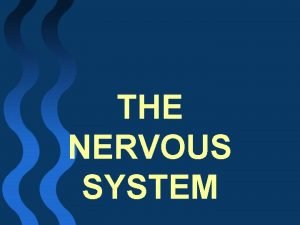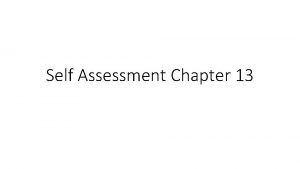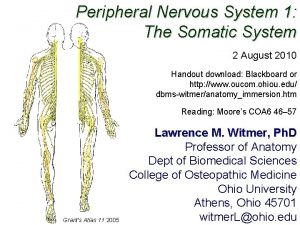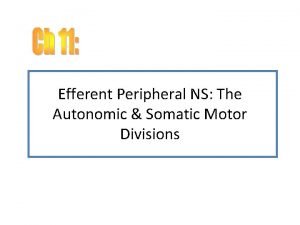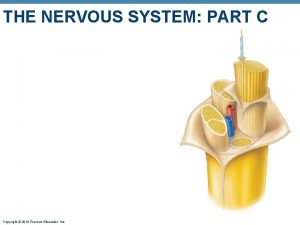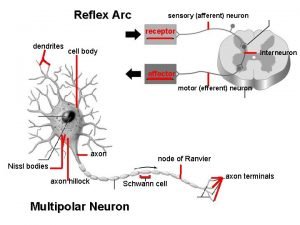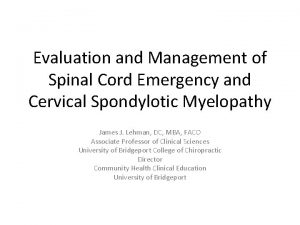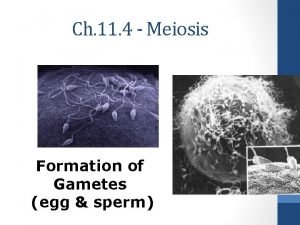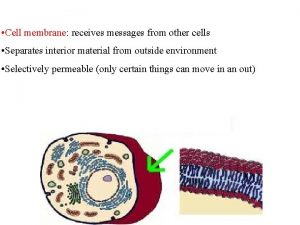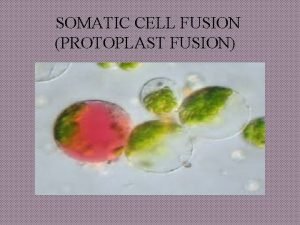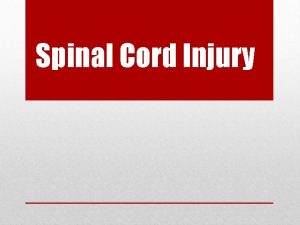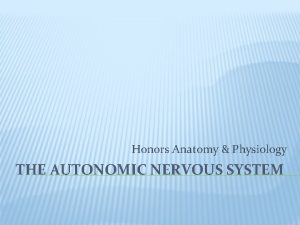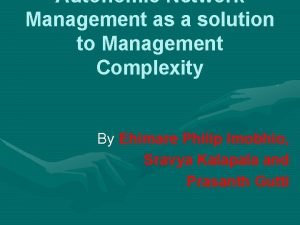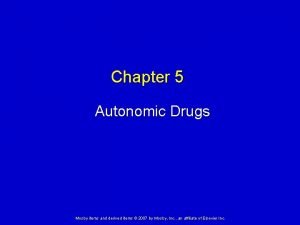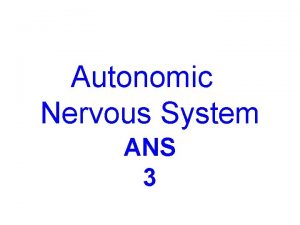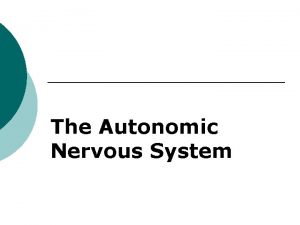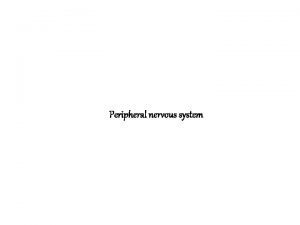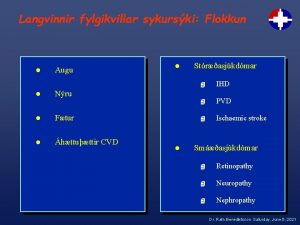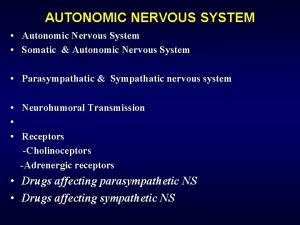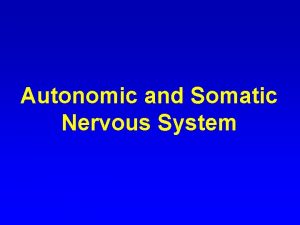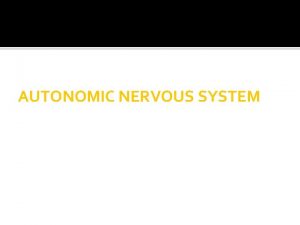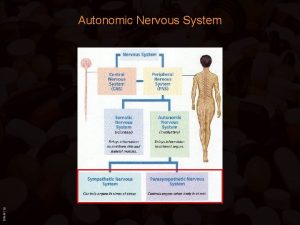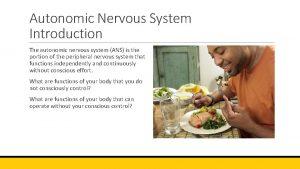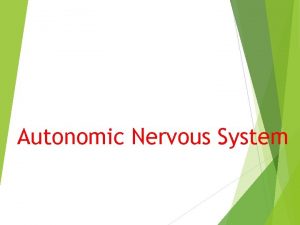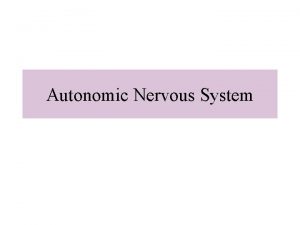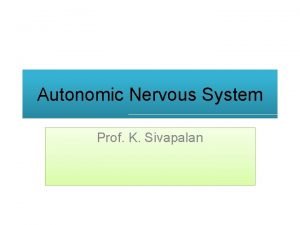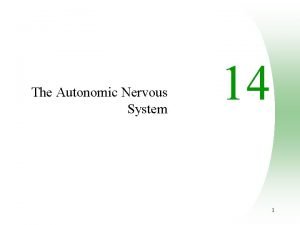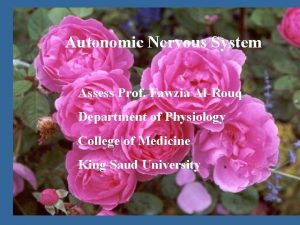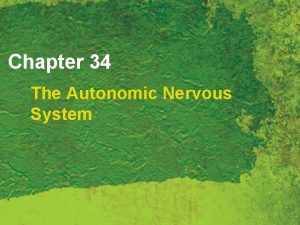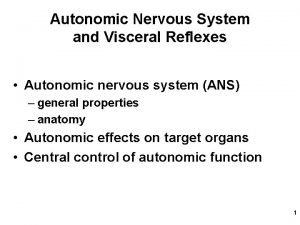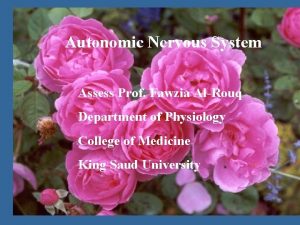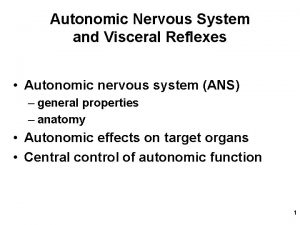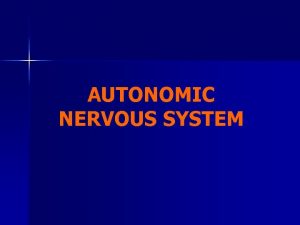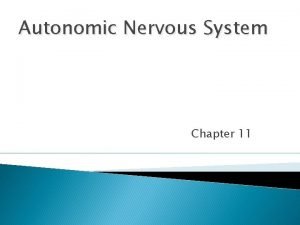Autonomic Nervous System Hypothalamus SOMATIC NERVOUS SYSTEM Cell









































- Slides: 41

Autonomic Nervous System & Hypothalamus SOMATIC NERVOUS SYSTEM Cell bodies in central nervous system Peripheral nervous system Neurotransmitter Effector at effector organs Effect Single neuron from CNS to effector organs ACh Stimulatory Heavily myelinated axon Skeletal muscle SYMPATHETIC PARASYMPATHETIC AUTONOMIC NERVOUS SYSTEM Two-neuron chain from CNS to effector organs NE ACh Lightly myelinated Ganglion preganglionic axons ACh Unmyelinated postganglionic axon Epinephrine and norepinephrine Adrenal medulla Blood vessel ACh Lightly myelinated preganglionic axon Unmyelinated Ganglion postganglionic axon ACh Stimulatory or inhibitory, depending on neurotransmitter and receptors on effector Smooth muscle organs (e. g. , in gut), glands, cardiac muscle December 2, 2013 Chapter 13: 508 Chapter 15: 575 - 587 Dr. Diane M. Jaworski 249

• Why do we need somatic and autonomic nervous systems? • How do the somatic and autonomic nervous systems differ? • How do the sympathetic and parasympathetic nervous systems differ? • How does the hypothalamus control homeostasis? 250

Why do we need somatic and autonomic nervous systems? The Somatic Nervous System (SNS) operates under conscious control to promote muscle contraction. Thus, muscles move only when instructed to! Would you want to constantly have to tell your heart to beat, lungs to breath, blood vessels to constrict or dilate to maintain blood pressure, sweat glands to cool you off, plus having to think about your food being moved through your digestive tract and urine filling your bladder? How would you be able to do anything else? ? What would happen to all these activities if you fell asleep? ? ? The Autonomic Nervous System (ANS) operates automatically without conscious instruction. The ANS modulates visceral effectors in the cardiovascular, respiratory, digestive, urinary, and reproductive systems. These systems always maintain a basal level of activity. Thus, we need to have one nervous system division to increase activity (Sympathetic NS) and another nervous system division to decrease activity (Parasympathetic NS). Both systems work together to maintain homeostasis. 251

How do the somatic and autonomic nervous systems differ? Somatic Nervous System Conscious cortical control of motor activity = voluntary Myelinated innervation of skeletal muscles by lower motor neurons (LMN) Only one synapse – on muscle Active only when stimulated Acetylcholine input to target Output is excitatory 252 © Mc. Kinley et al. A & P 2013

Autonomic Terminology • Preganglionic neurons - visceral motor neurons located in brainstem and spinal cord, synapse in autonomic ganglion, use acetylcholine • Axons of ganglionic neurons are called postganglionic axons – Cell body in autonomic ganglia – innervate visceral effectors: cardiac muscle glands blood vessels smooth muscle adipose tissues 253 © Mc. Kinley et al. A & P 2013

Autonomic Nervous System Involuntary control of visceral function Unmyelinated innervation of smooth and cardiac muscle, glands, and internal organs One synapse in PNS within ganglion One synapse on target Excitatory and inhibitory modulation of intrinsic target activity Utilizes multiple neurotransmitters and receptors 254 © 2005 Pearson Education

How do the somatic and autonomic nervous systems differ? - Conscious control - One neuron - One neurotransmitter (ACh) - Myelinated axon innervates effector - Innervate skeletal muscle - Only active when stimulated - Involuntary - Two neurons - Two neurotransmitters (ACh & NE) - Unmyelinated axon innervates effector - Innervates viscera - Always active, modulate activity 255

Somatic and autonomic nervous systems use different neurotransmitters One neurotransmitter, acetylcholine (ACh) Is always excitatory Just like the somatic nervous system, the pre-ganglionic neuron in the CNS releases ACh. The post-ganglionic neuron releases either ACh or norepinephrine. Depending on the receptor activated, the effect is excitatory or inhibitory. 256

Sympathetic versus Parasympathetic Nervous System 257 © Purves et al. Neuroscience 2008

Sympathetic = "fight, flight, and stress” Think “E” - exercise, excitement, emergency, embarrassment Readies the body for crisis: increases alertness & stimulates tissue metabolism Parasympathetic = "rest and digest” Think “D” – digestion, defecation (pooping), diuresis (peeing) Notice that almost all organs get dual innervation from both divisions. However, both divisions do not normally innervate organs equally. Also, those organs without dual innervation (e. g. , adrenal medulla, arrector pili muscle, sweat glands, and most blood vessels receive only sympathetic innervation) are regulated by increasing or decreasing the firing rate of sympathetic innervation. 258 © Mc. Kinley et al. A & P 2013

Notice that the Sympathetic & Parasympathetic axons originate in different regions of the CNS Sympathetic = thoracolumbar Parasympathetic = craniosacral * Vagus (CN X), which accounts for 75% of parasympathetic innervation, originates in the brainstem, but innervates organs at all spinal cord levels No parasympathetic innervation of cutaneous effectors (blood vessels, sweat glands, arrector pili muscles) and blood vessels in skeletal muscles. Remember that TWO output neurons are involved in autonomic reflexes – one in the CNS and one in the PNS Let’s see how this organization differs in the Sympathetic & Parasympathetic NS 259

Sympathetic Nervous System Preganglionic Postganglionic Eye Blood vessels and sweat glands of head Salivary glands Blood vessels Heart Spinal cord Right Left Cardiac and pulmonary plexuses Superior cervical ganglion Middle cervical ganglion Inferior cervical ganglion T 1 Postganglionic axons to skin, blood vessels T 1 T 2 T 3 T 4 T 5 T 6 T 7 T 8 T 9 T 10 T 11 T 12 L 1 L 2 Lung Celiac ganglion Greater thoracic Liver and splanchnic nerve gallbladder Spleen Lesser thoracic splanchnic nerve Least thoracic splanchnic nerve L 2 L 3 L 4 Stomach Adrenal medulla Kidney Ureter (proximal) Pancreas Superior mesenteric ganglion Inferior mesenteric ganglion Large intestine Small intestine Rectum Ureter (distal) Lumbar splanchnic nerves L 5 Hypogastric plexus Bladder S 1 S 2 Sympathetic trunk ganglia Ovary © Mc. Kinley et al. A & P 2013 Vas deferens Seminal vesicle Sacral splanchnic nerves Prostate Uterus Testis 260

Sympathetic Division Preganglionic neurons exit the thoracolumbar spinal cord (T 1 to L 2) and synapse on post-ganglionic neurons in the paravertebral ganglia or sympathetic ganglionic chain located close to the spinal cord. Thus, the preganglionic axon is very short. Preganglionic axons are short Postganglionic axons are very long © Mc. Kinley et al. A & P 2013 261

Sympathetic Division Preganglionic axons branch to synapse with several postganglionic neurons. The postganglionic axon then has to travel a long distance to the target organ. In some cases, the axons travel along the walls of blood vessels to get to their target. 262

Sympathetic Division Wow, that’s a pretty complicated system to respond to emergencies!!! 263

Sympathetic Division Some preganglionic fibers synapse in diffuse ganglion (collateral ganglion) located close to the organs that the postganglionic fibers will innervate (e. g. , digestive, urinary, reproductive systems). Other preganglionic fibers pass through the ganglia without synapsing. They terminate directly on the adrenal medulla & stimulate the secretion of epinephrine/adrenaline (80%) & norepinephrine/noradrenali ne (20%). 264

Parasympathetic Nervous System Preganglioni c Postganglionic Ciliary ganglion Lacrimal gland Pterygopalatine ganglion CN III CN VII CN IX Pons Parotid salivary gland Submandibular salivary gland Sublingual salivary gland Submandibular ganglion Otic ganglion Heart CN X Cardiac plexus Trachea Pulmonary plexus Esophageal plexus Lung Esophagus Liver Gallbladder Stomach Abdominal aortic plexus Spleen Spinal cord Kidney Ureter Pancreas Small intestine Hypogastric plexus Testis Ovary Descending colon Rectum S 2 S 3 S 4 Pelvic splanchnic nerves Bladder Penis 265 Uterus Vagina © Mc. Kinley et al. A & P 2013

Parasympathetic Division Ciliary ganglion CN III Lacrimal gland CN VII Pterygopalatine ganglion CN IX CN X Referred to as the Craniosacral division: Stimulates visceral activity, conserves energy/promotes sedentary activities Eye Submandibular ganglion Otic ganglion Nasal mucosa Submandibular and sublingual glands Parotid gland Cranial nerves III (pupil dilation), VII (saliva, tearing, nasal secretions), IX (saliva), X (saliva) Heart Cardiac and pulmonary plexuses Lung Sacral cord (S 2, 3, 4) to innervate bladder, bowel & reproductive organs Celiac plexus The Vagus nerve provides the major parasympathetic innervation to the heart, lungs, esophagus, stomach, pancreas, liver, small intestine, and upper half of the large intestine. Liver and gallbladder Stomach Pancreas S 2 Large intestine S 4 There is no parasympathetic innervation to limbs, skin or blood vessels. Small intestine Pelvic splanchnic nerves Inferior hypogastric plexus Wow, that was a lot easier than the Sympathetic Division!! Rectum Urinary bladder and ureters Genitalia (penis, clitoris, and vagina) Preganglionic Postganglionic CN Cranial nerve 266

Parasympathetic Nervous System Preganglionic neurons located in brainstem and sacral spinal cord Preganglionic axons are long since parasympathetic ganglia are located close to target organ and branch very little to give finer control Postganglionic axons are short © Mc. Kinley et al. A & P 2013 © 2005 Pearson Education 267

ANS Neurotransmitters • All preganglionic fibers release ACh • Parasympathetic: postganglionic fibers release ACh • Most Sympathetic postganglionic fibers release Norepinephrine (noradenaline) Exception: sweat glands release ACh 268

269 © 2005 Pearson Education

Parasympathetic Pathway Sympathetic Pathways Preganglionic axon releases ACh. Ganglionic neuron cell body and dendrites always contain receptors for ACh ACh Nicotinic receptors ACh NE Postganglionic axon releases ACh or NE. Muscarinic receptors Target cells contain either ACh receptors (bind ACh) or NE receptors (bind NE). © Mc. Kinley et al. A & P 2013 Target cell Muscarinic receptors Target cell (e. g. , sweat glands and blood vessels in skeletal muscle) Adrenergic receptors Target cell (e. g. , most other body structures) 270

All pre-ganglionic CNS neurons release ACh that binds to nicotinic ACh receptors - on muscles (somatic NS) - in parasympathetic ganglion - in the adrenal gland ACh binding to nicotinic receptors is ALWAYS STIMULATORY! ANS Neurotransmitter Receptors Post-ganglionic parasympathetic neurons release ACh that binds to muscarinic ACh receptors on target tissues (inhibitory or excitatory) Post-ganglionic sympathetic neurons release norepinephrine/epinephrine that binds to & adrenergic receptors on target tissues (NE targets receptors & epinephrine targets receptors). More info in 271

What happens to the organs in response to these stimuli? Sympathetic Heart rate? Increase Parasympathetic Decrease Blood pressure? Decrease Breathing rate? Increase Decrease Pupil size? Gut motility? Increase Decrease Increase Fill in the info above with “increases” or “decreases” 272

Drugs of abuse • Sympathomimetic (mimics the sympathetic NS) : high BP, tachycardia (speeding heart rate), anxiety, hyperthermia, pupil dilation, sweating – Cocaine blocks reuptake of norepi, and dopamine • Cholinergic (ACh stimulants) – mushrooms (muscarine) – SLUDGE: Salivate, Lacrimate, Urinate, Defecate, Emesis (vomiting) and other gastrointestinal effects, bradycardia (slow heart rate) • Anticholinergics– many antihistamine drugs, tricyclic antidepressants – Hot as a hare – Blind as a bat – Dry as a bone – Red as a beet – Mad as a hatter 273

Enteric Nervous System • Third division of Autonomic NS • Contains same neurotransmitters as found in the brain • Allows for complex visceral reflexes to be coordinated locally The enteric nervous system will be discussed in ANP 20 with the digestive system 274

Autonomic Integration • Medulla Oblongata – Contains nuclei involved in: • salivation • swallowing • digestive secretions • peristalsis (visceral movements) • urinary function – Regulated by hypothalamus • Hypothalamus - Highest command center for autonomic homeostatic control (other than the cerebral cortex!) © Mc. Kinley et al. A & P 2013 © 2005 Pearson Education Cranial Nerves Spinal Nerves 275

Hypothalamus maintains homeostatic setpoints 276

The Hypothalamus is part of the Diencephalon • Lies below thalamus 277

External Structures of the Hypothalamus Mamillary bodies: - process olfactory and other sensory information - control reflexive eating movements: In the movie Awakenings the people who were “frozen” ate using the reflex centers here and the swallowing centers in the medulla • Infundibulum: – connects hypothalamus to pituitary gland 278

The Hypothalamus is made of many small nuclei (neuron clusters) Each individual nucleus has a unique function 279

The hypothalamus regulates the endocrine system via the pituitary Hypothalamus makes Releasing Factors to stimulate the Pituitary Gland makes Stimulating Factors to stimulate glands to make hormones Endocrinology will be discussed in greater detail in ANP 20 280

The Hypothalamus Regulates Circadian (daily) Rhythms: Sleep Melatonin maintains sleep “Biologic Clock” is the suprachiasmatic nucleus Regulation of Pineal Gland (melatonin) Melatonin is only made at night You wake up when your melatonin level drops enough to activate the reticular activating system 281

The Hypothalamus Regulates Water Balance • Regulates kidney function (retain water) • Supraoptic nucleus secretes antidiuretic hormone (ADH) • Damage to supraoptic nucleus results in diabetes insipidus = pee more + drink more • “Thirst Center” – Stimulates drinking behavior 282

The Hypothalamus Regulates Food Intake • “Satiety Center” regulates fullness, suppresses eating behavior • “Feeding Center” stimulates food consumption 283

Responds to peripheral signals – Leptin from fat cells - inhibit feeding – Ghrelin from stomach - stimulate feeding – Insulin from pancreas - inhibit feeding 284

Genetics contribute to Obesity 285

Environmental Factors contribute as well 286

The Hypothalamus Regulates Body Temperature • Preoptic area of hypothalamus is the site of the body’s “thermostat” • Initiates sweating (to reduce body heat) • Initiates shivering (to increase body heat) Thermoregulatory sweating is regulated by hypothalamus Emotional sweating is regulated by the limbic system 287

The Hypothalamus controls the ANS Hypothalamic neurons send axons down the brainstem and spinal cord to synapse in areas controlling : Cardiovascular function (heart rate, blood pressure) Respiration Digestion Reproductive Activity Much more… 288

The Hypothalamus regulates MANY behaviors via its interaction with the limbic system 289
 Skeletal muscle autonomic nervous system
Skeletal muscle autonomic nervous system Divisions of the nervous system
Divisions of the nervous system Autonomic receptors
Autonomic receptors Preganglionic fibres
Preganglionic fibres Alpha 1 receptors
Alpha 1 receptors Autonomic nervous system consists of
Autonomic nervous system consists of Visceral reflex
Visceral reflex Autonomic nervous system
Autonomic nervous system The autonomic nervous system controls
The autonomic nervous system controls Autonomic nervous system visceral
Autonomic nervous system visceral Autonomic nervous system
Autonomic nervous system Sns somatic nervous system
Sns somatic nervous system Somatic nervous system
Somatic nervous system Somatic nervous system neurotransmitters
Somatic nervous system neurotransmitters Visceral nervous system
Visceral nervous system Nerves
Nerves Somatic nervous system
Somatic nervous system Somatic nervous system
Somatic nervous system What are the characteristics of nervous tissue
What are the characteristics of nervous tissue Fundamentals of the nervous system and nervous tissue
Fundamentals of the nervous system and nervous tissue Processes of neuron
Processes of neuron Structure of spinal cord
Structure of spinal cord How are mitosis and meiosis similar
How are mitosis and meiosis similar Site of somatic motor neuron cell bodies
Site of somatic motor neuron cell bodies Lmnl vs umnl
Lmnl vs umnl Somatic vs gamete
Somatic vs gamete Germ cell vs somatic cells
Germ cell vs somatic cells Protoplast fusion
Protoplast fusion A26
A26 Autonomic nerveous system
Autonomic nerveous system Automatic bladder vs autonomic bladder
Automatic bladder vs autonomic bladder Ans
Ans Autonomic network management
Autonomic network management An architectural blueprint for autonomic computing
An architectural blueprint for autonomic computing Mosby items and derived items
Mosby items and derived items Autonomic drugs
Autonomic drugs The vision of autonomic computing
The vision of autonomic computing Ans hypothalamus
Ans hypothalamus Autonomic state
Autonomic state Autonomic computing ibm
Autonomic computing ibm Diabetic autonomic neuropathy
Diabetic autonomic neuropathy Automatic bladder
Automatic bladder



